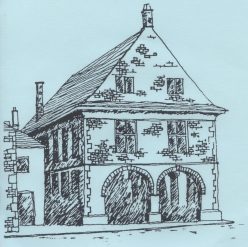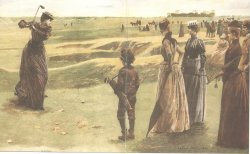By the C19th Minchinhampton Common was beginning to assume its role for recreation, in addition to that of common farmland. In Victorian times the duty of administering the common pasture was gradually assumed by a Committee of Commoners, which kept detailed minutes. They were concerned for their cattle, and damage of any sort to the turf brought an immediate response. In 1847 James Harrison of Littleworth was threatened with prosecution for “injuring a stone trough”. It had previously been reported that the weather had been so unusual that all the pools on the commons had dried, and water for the beasts was only obtained with great difficulty. Other issues tackled were taking land into the Common, dealing with straying cattle and with the quarries.
There were two large areas of arable land left, one to the north of Box and the other stretching in a broad arc northwards from the windmill. When an occupier of land wished to straighten his boundary or enlarge his garden permission was granted provided he threw into the common as large, or a larger piece of ground. Mrs. Frith made the road from the Halfway House to Tom Longs Post, in return for taking in 3½ acres of common land into the grounds of Highlands, now Beaudesert School. Near Windmill House the footings of the original wall of the field at Charity Barn can be seen.
As the Ricardo family lived at Gatcombe, their old park had become somewhat of a public open space, although it was never part of Minchinhampton Common, with all the rights that entailed. Along the northern boundary of the Great Park was a wall and ditch with entrance gateways or arches, still visible in the line of brambles today.
Cricket was played on Minchinhampton Common, near to the windmill although conditions were far from ideal, a match between Nailsworth and Minchinhampton yielding a score of visitors 26, home team 86! There would be a mown strip, as the early accounts of this local M.C.C. indicate, but this would not have been rolled, and bouncers would catch many experienced batsmen unawares. The open land was undoubtedly the scene of many local sporting events, from football to horse racing, and the area by Dr. Brown’s Road, then part of Burleigh Lane, was regularly used for military gatherings and manoeuvres, thus acquiring the name Camp Field; a copse of trees and a flagstaff marked the centre of the parade area.
In the history of sport a date of national significance is March 14th 1889, when the Minchinhampton Commons Golf Club was formed, and it was decided that the headquarters would be the Old Lodge. The Lodge had become an inn by the beginning of the C18th and is shown on maps of the period with a small enclosure to the west and a bowling green to the east; some notable extensions to the building took place at this time. The name Old Lodge was coined when a New Lodge Inn was opened in Amberley in the C19th, and the close link with the Golf Club remained for over a century. A national periodical stated: “perhaps the best inland golfing course is Minchinhampton Common, … with picturesque surroundings and an exceptionally pure and bracing air”.
In the same year the Minutes of the Committee of Commoners report that Mr. Shipway asked, “On what authority were holes made on the Common?” The Chairman, Mr. Playne, himself a keen golfer, said that the Lord of the Manor had given permission and that he hoped there was not going to be any objection to a game that brought strangers into the area. It was not the game Mr. Shipway objected to but players who had threatened to prosecute people who complained; the holes were four inches wide and quite enough to lame a horse. Many men were members both of the Golf Club and Commoners Committee, the dispute died away, and the two have existed side by side ever since. H.G. Ricardo sold the Great Park to Minchinhampton Golf Club in 1907, the wall was removed and thirty acres of grazing land were added to the common pasture “for grazing in return for the Club’s formal right to play golf and maintain the course”.
The Ricardo family continued as Lords of the Manor throughout the C19th and early C20th, taking their responsibilities seriously. In response to growing fears about piecemeal quarrying destroying Minchinhampton Common, and thus the grazing, Major H.G. Ricardo signed an agreement with the National Trust in 1913, so that it should be “devoted to the enjoyment of the public and … preserving the natural aspect and features of the said common”. It was not until 1981 that the Golf Club offered the Great Park for sale at £15,000, plus legal fees, to the people of Minchinhampton. A public appeal was launched in conjunction with the National Trust, the money was raised and the land finally passed into public ownership.
–

